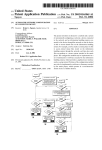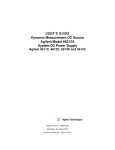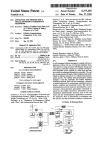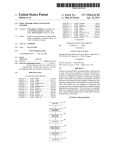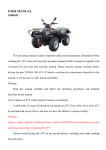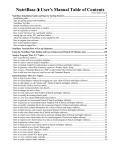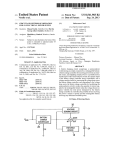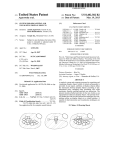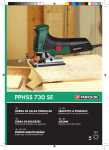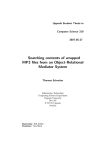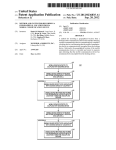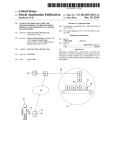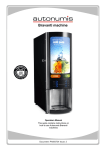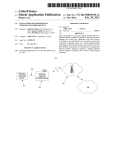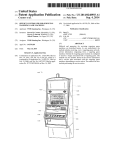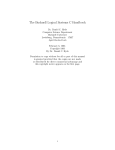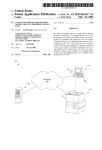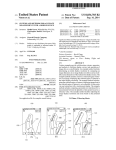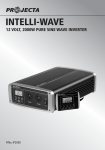Download Applications for mobile computing devices
Transcript
US 20090322761A1
(19) United States
(12) Patent Application Publication (10) Pub. No.: US 2009/0322761 A1
Phills
(54)
(43) Pub. Date:
APPLICATIONS FOR MOBILE COMPUTING
DEVICES
_
G06T 15/70
Correspondence Address;
SONNENSCHEIN NATH & ROSENTHAL LLP
(52)
P.0. BOX 061080, WACKER DRIVE STATION,
(57)
606 1080 U s
_
(
(21) Appl' NO"
(22) Filed
(2006.01)
H04M 1/00
(200601)
A63F 13/00
(2006.01)
US. Cl. .......................... .. 345/473; 455/566; 463/37
ABSTRACT
A sequence of images is displayed in response to user input,
)
such as an ansWer to a question, a touch and drag operation, a
_
'
Int. Cl.
ajlstilony Phills, WestWood, CA
’
tap operation or shaking of a mobile device. The images may
12/255’891
Oct 22 2008
'
be displayed in an order determined by a direction implied by
the user input, and may be accompanied by music. The dis
’
play of the sequence of images may continue for a time
.
(60)
Publication Classi?cation
(51)
.
(76) Inventor.
Dec. 31, 2009
.
determined by the shaking of the device prior to commence
Related U's' Apphcatlon Data
Provisional application NO_ 61 /076,133, ?led on Jun,
26, 2008.
ment of the display of the sequence of images. The sequence
of images may depict a common constituent in successively
different poses or states.
.(is Hii
n
Dispiay initial image from sequence of images (egq
human wearing one or more aiiiciea of ciotiiing).
4 m,
Wait for user input
‘I!
Receive user inpul
Dismay next image from thrz sequence of images
(e9), human wearing one ormnre iewat articles of
clothing than in previously dismayed image}.
34
‘(V More images?\ I
5
Patent Application Publication
Dec. 31, 2009 Sheet 1 0f 8
US 2009/0322761 A1
User Manipuiabie
Gnmpnnent i1
Cnmput'mg Gev'ice
>
x
\\\\\\\\\\\\\\\\\\\\\\\\\\\\\\\\\\\\“
.V.V.V.V.V.V.V.
.V.V.V.V.V.V
\h
.V. V.V.V.V.V.
.V.Vx
E
Qk
?epmiltowy
15
t
............................ S
§
S
,
.
Dis Ia
Figure1
‘if; if
............................ ..
M
I
I
Figure 2
I
image M
2m
Patent Application Publication
Dec. 31, 2009 Sheet 2 0f 8
US 2009/0322761 A1
Dispiay
humaniniiia‘i
Wearing
image
one{mm
13!‘ more
sequence
amides
0? an‘
‘images
clothing);
(e9;i '
‘
Dispiay' next; image from ‘the sequence Qf'images
‘ {Lagciuihing
humanthan
wearing
in previously
one or mare
disptayed
feweramcies
image}. uf
3::
/gw4, ,m._n?
Figure 13A
_
Patent Application Publication
Dec. 31, 2009 Sheet 3 0f 8
US 2009/0322761 A1
................................. H,
5_ Dismay initiai imaga fmm sequ-anca m‘ images {eg: 3
human wearing one or mom articias of defining)‘
E
i .
.
.
.
.
.
.
.
.
.
.
.
.
.
.
.
.
.
.
.
.
.
.
.
.
.
.
.
.
.
.
.
.
.
.
.
.
.
.
.
.
.
.
.
.
.
.
.
.
.
. \
.
.
.
.
.
.
.
.
.
.
.
.
. . .
.
.
.
.
.
.
.
.
.
.
.
.
.
. . .
.
.
.
. . .
.
.
.
.
.
.
.
.
.
.
.
.
.
. . .
.
.
.
. . .
.
.
.
. . .
.
.
.\
. . . .\
-------------------------------------------------------------------------------------------------------------------------------------------------------------------------------------------------------- A
;4/ 1/ 1”),
Yes
’ Dismay
'
next-imageacmrdingm
afusserinputdeter-mined
'
direction
'
'3
~
.
.
.
.
.
.
.
.
.
.
.
.
.
.
.
.
.
.
.
.
.
.
.
.
.
.
.
.
.
.
.
.
.
.
.
.
.
.
.
.
.
.
.
.
.
.
.
.
.
.
\
.
.
.
.
.
.
.
.
.
.
.
.
.
.
.
.
.
Mma imagess? ' _
\_
39
Figure 13B
.
.
.
.
.
.
.
.
.
.
.
.
.
.
.
.
.
.
.
.
.
.
.
.
.
.
.
.
.
.
.
.
.
Patent Application Publication
Dec. 31, 2009 Sheet 4 0f 8
US 2009/0322761 A1
Gispiay initial image from sequemse afimages {e9
1
human wearing one qr mom art'ic‘ies m‘ ciaiihin'g},
Wait‘ for spatiat' dispiacement
\ .\\\\\\\\\\\\\\\\\\\\\\\\\\\\é
'
Sense spati'ai diispiac'ement
43
I Display next image frbm the’ maximum of images 4
{sagciet'hing
, hum an
than
wearing
in pr'emusiy
one 0r displayed
more! fewer
image
articles
} Uf
44
g/al1 ’”1,4;
Figure 4
Patent Application Publication
Spiiwai Aw: M
:
\
Dec. 31, 2009 Sheet 5 0f 8
US 2009/0322761 A1
Patent Application Publication
Dec. 31, 2009 Sheet 6 0f 8
US 2009/0322761 A1
53:1
1. 4
F igum 5E
Patent Application Publication
Dec. 31, 2009 Sheet 7 0f 8
'\ 100
Figure 5F
US 2009/0322761 A1
Patent Application Publication
Dec. 31, 2009 Sheet 8 0f 8
US 2009/0322761 A1
ware mm if‘: an $13235?
.N.
US 2009/0322761 A1
APPLICATIONS FOR MOBILE COMPUTING
DEVICES
Dec. 31, 2009
images may be advertisements or advertisements may
accompany the display of the images.
BRIEF DESCRIPTION OF THE DRAWINGS
RELATED APPLICATION
[0001] This application is a nonprovisional of and claims
priority to US. Provisional Patent Application 61/076,133,
?led Jun. 26, 2008, Which is incorporated herein by reference.
[0006] The present invention is illustrated by Way of
example, and not limitation, in the ?gures of the accompany
ing draWings, in Which:
COPYRIGHT NOTICE
[0007] FIG. 1 depicts a block diagram of a system 10,
con?gured according to one embodiment of the invention.
[0008] FIG. 2 illustrates an example of the display of a
[0002] A portion of the disclosure of this patent document
contains material Which is subject to copyright protection.
dance With embodiments of the present invention.
[0009] FIGS. 3A and 3B are How diagrams illustrating
The copyright oWner has no objection to the facsimile repro
duction by anyone of the patent document or the patent dis
closure, as it appears in the Patent and Trademark O?ice
patent ?le or records, but otherWise reserves all copyright
rights Whatsoever.
sequence of images on a mobile computing device in accor
examples of processes for displaying sequences of images in
response to user input in accordance With embodiments of the
present invention.
[0010] FIG. 4 is a How diagram illustrating a further
example of a process for displaying sequences of images in
response to user input in accordance With embodiments of the
present invention.
FIELD OF THE INVENTION
[0011]
FIGS. SA-SF are examples of user interfaces to
prompt user input for the displaying of sequences of images in
[0003] The present invention relates generally to the ?eld of
applications for mobile computing devices, such as mobile
phones, personal digital assistants, portable media players
and the like, and more particularly to entertainment applica
tions for such mobile computing devices.
BACKGROUND
[0004] The advent of mobile computing devices such as the
BlackBerryTM and iPhoneTM have occasioned a signi?cant
increase in the number of applications being developed for
these platforms. While many such applications have a busi
ness purpose, some are intended simply for user entertain
ment. To date, most of these entertainment applications have
focused on the display of rich graphical environments similar
to those found in video games and the like. Other entertain
ment applications involve the playing of movies, television
programs and music.
SUMMARY OF THE INVENTION
[0005]
The present invention provides for displaying, in
response to user input, a sequence of images on a display of a
mobile device, Wherein the sequence of images a common
constituent in successively different poses or states and the
user input comprises entering an ansWer to a question, or
performing at least one of: a touch and drag operation or a tap
operation, or shaking of the mobile device. The images may
be displayed in an order determined by a direction implied by
the user input, for example a direction of the touch and drag
operation or the shaking. The sequence in Which the images
are displayed may he determined by a user input other than
response thereto in accordance With embodiments of the
present invention.
[0012] FIGS. 6A-6c illustrate additional examples of user
interfaces to prompt user input for the displaying of
sequences of images (this time designed to simulate pieces of
a jigsaW puZZle) in response thereto in accordance With
embodiments of the present invention
DETAILED DESCRIPTION
[0013] A system, variously a mobile phone, a personal
digital assistant, a portable music player, a portable computer,
a portable camera, or similar device, hereinafter collectively
referred to as a “device”, con?gured in accordance With
embodiments of the present invention is con?gured to display
a sequence of images in response to user manipulation of the
device. More speci?cally, various ones of the images are
displayed in sequence (or in an order other than sequential,
e.g., random, pseudo random, or determined by a measure of
the input applied to the device or other factor) on a display of
the device responsive to user manipulation of the device. The
user manipulation may take the form of oscillating (e. g.,
shaking) the device, manipulating a cursor control interface
(e.g., a trackball), manipulating one or more human input
interfaces (e.g., buttons, sWitches, a touch screen, etc.), or
voice commands input via a microphone. In the description
beloW, reference Will be made to shaking a device con?gured
With accelerometers or other sensors that alloW for registering
such user manipulation, but any of the above forms of input
should be understood to be encompassed Within the broader
scope of the invention.
[0014] In one particular embodiment of the invention, the
sequence of images depict a human model Wearing succes
the touch and drag operation, the tap operation or the shaking
sively feWer articles of clothing. Thus, shaking the device
of the mobile device, and may, in some cases, be accompanied
causes the sequence of images to be displayed so as to suggest
that the model removes articles of clothes in response to the
by music. In one particular instance, the sequence of images
is displayed in response to the shaking of the device and an
additional user input, for example an indication that the dis
play of the sequence of images should commence. The dis
play of the sequence of images may continue for a time
determined by the shaking of the device prior to commence
ment of the display of the sequence of images. Some of the
shaking. In some instances the sequence of images begins
playing as soon as the shaking commences, but in other cases
the amount (or vigorousness) of shaking is measured and
translated by the device into a stored metric (e.g., “energy”)
and the sequence of images played out to a point according to
the value of the stored metric. For example, if a user shakes
US 2009/0322761 Al
Dec. 31, 2009
the device suf?ciently to store 50% energy (Where energy is
[0019]
used simply as a term of convenience and should not neces
sarily be inferred to represent a true measure of energy
images Which computing device 13 is programmed to display
imparted by the user manipulation), then one half of the
sequence of images that make up a complete image collection
Will be subsequently played (e.g., in response to a separate
user input indicating a desired to commence the playing of the
image sequence). The amount of stored “energy” may be
presented to the user so that s/he knoWs hoW much more
shaking (or other manipulation) is required in order to achieve
a desired length of image sequence play.
[0015] More generally, the present invention provides for a
sequence of images to advance in display in response to user
input. The sequence of images may be a deterministic
sequence (i.e., the same sequence of images may be displayed
every time), or a non-deterministic sequence (i.e., the order in
Which the images are presented may vary from one playing to
another). Different sequences of images may be collected in a
As indicated above, in one instance the sequence of
concern a human being. In each of a successive one of the
images, that individual is shoWn With successively feWer
articles of clothing. Consequently, as the images are pre
sented one by one in response to the user input (e.g., the
scrolling of a trackball, the shaking of the device, etc.), the
individual depicted in the images appears to the user to be
disrobing in response to the user input. That is, the sequence
of images in a particular set advances in response to the user
input (or in accordance With an amount of “energy” stored in
response to user inputs) and the details shoWn in the indi
vidual images that make up the sequence are successively
revealed to the user. One example of a process for implement
ing this behavior (e. g., through execution of appropriate com
puter-readable instructions) is discussed beloW in connection
With a description of various ?oW diagrams.
collection or set, and different sets of images may be stored on
[0020]
computer-readable media Within or accessible by the device.
Various forms of user input or manipulation may be used,
including, but not limited to, the manipulation of a user
images presented is not unlike the experience of using a
manipulable component such as a trackball and/or the dis
placement of one or more spatial displacement sensors, such
To a user, the effect of having the sequence of
novelty pen in Which an image of a clothed person is embed
ded Within a barrel of the pen and, When the pen is inverted,
the clothing in the image falls aWay to reveal an unclothed
instance of the image of the person. If the pen is inverted
as accelerometers. In some cases, touch screen inputs in the
again, the clothing is replaced. Similarly, in the case of the
form of gestures may be used as user inputs.
present invention, one set of user inputs sensed by the com
puting device may case the sequence of images to proceed in
[0016] FIG. 1 depicts a block diagram of a system 10,
con?gured according to one embodiment of the invention.
System 10 may be a mobile computing device, such as mobile
like. System 10 includes at least one of a user-manipulable
one direction (presenting an individual Wearing successively
feWer articles of clothing) and another set of user inputs may
cause the images to play in the reverse direction (presenting
an individual Wearing successively more articles of clothing).
component 11 (e.g., a trackball, touch screen, joystick, etc.)
In one example, rolling a trackball in one direction causes the
and at least one spatial displacement sensor 12 (e.g., an accel
erometer, Which may be a multi-axis accelerometer) commu
nicatively connected to a computing device 13. More gener
ally, system 10 may include one or more user-manipulable
components 11, one or more spatial displacement sensors 12,
or a combination of user-manipulable components 11 and
sequence of images to play in a “forWard” direction and
rolling the trackball in the opposite direction causes the
sequence of images to play in a “reverse” direction. Many
other variants of this playing forWards and backWards are
possible and the invention is not limited to just tWo-dimen
sional control of the playing of sequences of images. For
example, different sets of images may be presented if the user
input is made in a direction orthogonal to an original input
(similar to turning pages in a book).
phone, personal digital assistant, portable media player or the
spatial displacement sensors 12 interfaced With computing
device 13.
[0017] Computing device 13 contains repository 15, Which
is adapted to store digital images and/or computer readable
instructions. For example, repository 15 may be a computer
[0021]
In one embodiment, one or more of elements 11-15
may be included in a mobile computing device including, but
readable medium (such as a solid state memory) storing com
not limited to, an iPhoneTM or iPodTM (available from
puter-readable instructions, Which instructions, When
executed by computing device 13, cause the computing
AppleTM of Cupertino, Calif.) a smartphone, a cellular or
device to perform operations that result in the display of
Research in MotionTM of Waterloo, ON), a calculator, a
Watch, a graphing calculator, a Wireless WiiTM remote control
images in response to user manipulations of system 10 as
other mobile phone, a BlackBerryTM (available from
discussed herein. Other examples of computer readable
(available from NintendoTM Company Co., Ltd. of Koyoto,
media suitable for use in accordance With the present inven
Japan), or other device or remote control. Thus, elements
11-15 of system 10 may be integrated on a single device, or
may be located on separate devices or in separate modules.
tion include random-access memories (RAMs), read-only
memories (ROMs), erasable programmable read-only
memories (EPROMs), electrically erasable programmable
For example, user manipulable component 11 and spatial
read-only memories (EEPROMs), and magnetic disks, or
displacement sensor 12 may be located on a Wireless Wii
combinations thereof, to name a feW. The present invention is
not limited to the use of one particular form of device or form
remote control, computing device 13 may be located in a Wii
video game console communicatively coupled to the Wii
of computing device or computer-readable memory
remote control, and display 14 may be a television or other
[0018]
display device communicatively coupled to the Wii console.
[0022] A user-manipulable component includes, but is not
To facilitate the display of the images, computing
device 13 is further interfaced With display 14. Display 14
may be a liquid crystal display (LCD), a touch-screen display,
or a re?ective display based on interferometric modulation
(IMOD) technology. The interfaces betWeen components
11-15 include, but are not limited to, electrical, Wireless,
and/ or optical interfaces.
limited to, a clicker, a key, a scroll Wheel, a slider, a button, a
trackball, a tumable knob, or a touch-screen display. More
user-manipulable components include the scroll Wheel on an
iPod, and the trackball on a mobile computing device. A
spatial displacement sensor includes, but is not limited to, an
US 2009/0322761 A1
accelerometer, a gyroscope, a global positioning system
(GPS) receiver, and a light sensor.
[0023]
In one embodiment of the invention, a sequence of
images, such as those depicted in FIG. 2, is displayed on
display 14. Image 1 (21a) depicts the ?rst image from the
sequence of images; Image 2 (21b) depicts the second image
from the sequence of images; and Image N (2111) depicts the
Dec. 31, 2009
of images to display, for example, in response to a particularly
violent input (perhaps representative of an impatient user),
the next image displayed may be the last image in the
sequence (depicting the human Without any articles of cloth
ing). Alternatively, if there is a long delay betWeen user
inputs, the user may be penaliZed and the next image may be
of the human Wearing even more articles of clothing than Was
?nal image from the sequence of images, Where N is a natural
the case for the previously displayed image. Many forms of
number. Image 1 may depict a human Wearing one or more
games can be implemented around this notion of sequential
display of images and the present invention is not restricted to
articles of clothing; image 2 may depict the human Wearing
one or more feWer articles of clothing than Were present in
only one or a feW such games. Some of the games may involve
image 1; and image N may depict the human Wearing one or
more feWer articles of clothing than Were present in image 2.
the user agreeing to vieW certain advertising in conjunction
In one embodiment of the invention, Image N may depict a
human Wearing no articles of clothing. It is understood that
the same human may be depicted throughout the sequence of
images. It is also possible for different humans to be depicted
through the sequence of images. More generally, Within any
given sequence of images each image may depict a common
With or betWeen the display of desired images and the user
may only be permitted to vieW the nest image in a sequence of
images after vieWing one or more advertisements. Although
these sorts of games are not highlighted in the ?gure, they are
contemplated Within the scope of the present invention.
[0028]
If there are more images in the sequence available to
be displayed (step 34), system 10, once again, Waits for user
constituent (e.g., a person, an animal, an object, etc.) in suc
cessively different poses or states.
input (step 32). Otherwise, the process terminates (step 36)
[0024]
played. Note, in some cases, the display of images has been
An article of clothing includes, but is not limited to,
once all the images in a particular sequence have been dis
a T-shirt, a jacket, a vest, a sWeater, pants, shorts, a hat, socks,
an apron, a dress, and underWear. In another embodiment of
referred to as the playing thereof, but it is important to rec
the invention, articles other than clothing may be Worn by the
human including, but not limited to, jeWelry, a pair of shoes,
and eyeglasses. The individual depicted in the sequence of
crete images and not the playing of a movie or movie clip,
Which itself may be a sequence of images but Which are
images may be a male or a female. In another embodiment of
the invention, images 21a-21n each include one or more
humans. Images 21a-21n may depict an illustration or a pho
tograph of a human Wearing one or more articles of clothing.
out a pause or interruption therebetWeen (even though user
[0025]
For example, image 1 may depict a female Wearing
a hat, a dress, and socks. Image 2 may depict the female
Wearing a hat and socks. Finally, image N may depict the
female Wearing no articles of clothing. Note, at one or more
ogniZe that the present invention involves the display of dis
intended to be played sequentially, one after the other, With
controls may permit paying on a particular image in the
movie). The difference is more than semantics. Different ?le
types and players are involved.
[0029] Note that not shoWn in this illustration, but shoWn in
connection With process 30' in FIG. 3B, is an example of the
process Where images may be played in either a forWard or a
points in the display of the sequence of images, an audio ?le
may be played to provide additional user entertainment.
backWards direction (Within the sequence of images). That is,
prior to playing a particular image from the sequence (step
38), the computing device may determine Which next image
[0026]
FIG. 3A illustrates one example of a process 30 for
to present based on the type or direction of user input received
presenting a sequence of images to a user via a display of a
(step 37). If the user input is in the forWard direction, the next
forWard image is played. If the user input is in the reverse
direction, the next backWards image is played. If the user
input is in an orthogonal (e.g., left or right) direction, a ?rst
image of a neW sequence of images may be played (the ?rst
image may be the initial image of a sequence or an image
from a point in the neW sequence that corresponds to a point
in the current sequence). As before, if there are more images
device according to the present invention. An initial image,
from a sequence of images (e.g., depicting a human Wearing
one or more articles of clothing) is displayed on display 14
(step 31). This display of the initial image may be responsive
to a user activating an application program con?gured to
presentation of the sequence of images responsive to user
input. For example, the user may launch an appropriate appli
cation by selecting same from a menu or by selecting an icon.
In other instances, the user may launch the application using
a voice command. Such methods for initiating an application
are not critical to the present invention, but are all contem
plated Within the scope thereof.
[0027] System 10 Waits for user input (step 32). The user
input may be received by user manipulable component 11 or
spatial displacement sensor 12 (step 33). In response to the
user input, a next image from the sequence of images is
displayed on display 14 (step 34). This next image may, in one
example, depict the human shoWn in the previous image
Wearing one or more feWer articles of clothing than Was the
case in the previous image in the sequence. Alternatively, if
the images are shoWn in a sequence other than a linear order,
the human may be Wearing more articles of clothing than Was
the case in the previous image displayed to the user. In some
instances, the device may measure the user’s interaction With
the application and determine What image from the sequence
to play the system permits further user input (step 39). Since
there Will alWays be further images (e.g., even if only in the
reverse direction), play may continue until the user quits the
application (e.g., by selecting a quit function or menu com
mand (not shoWn)).
[0030]
In other examples, the images of a sequence are
played one by one, regardless of the speed or displacement of
the user input, Whereas in other cases the speed and/or dis
placement of the user input may determine from hoW far
ahead (or behind) in the sequence the next image for presen
tation is selected. This Way, impatient users may be accom
modated. In one particular instance of the process, the
sequence of images is displayed on a mobile computing
device, such as a handheld device, and the user-manipulable
component is a trackball. The rate at Which the user rolls the
trackball is correlated With the rate at Which the sequence of
images advances. Thus, if a user rolls the trackball at a fast
rate, the sequence of images advances at a fast rate. In other
US 2009/0322761 A1
cases, the shaking of a device controls the presentation of
images and images Within the sequence may be presented in
accordance With the amount of shaking provided by the user
(e. g., as measured by an accelerometer over a predetermined
time interval or other means).
[0031]
Still another example of a process 40 con?gured in
accordance With an embodiment of the present invention is
shoWn in the How diagram depicted in FIG. 4. An initial image
(e. g., one depicting a human Wearing one or more articles of
clothing) is displayed on display 14 (step 41). System 10
Waits for spatial displacement (step 42). Spatial displacement
is sensed by spatial displacement sensor 12 (step 43). In
response to spatial displacement, a next image depicting the
Dec. 31, 2009
sors). In FIG. 5A an image 50 is shoWn on display 14. Image
50 may be an initial image that is displayed When an appli
cation is launched on the device. Also displayed at this time
are three icons, 52a, 52b and 520, Which alloW the user to
designate What form of input Will be used in order to play the
sequence of images associated With the application. Icon 52a
corresponds to tap inputs (i.e., direct input via the touch
screen), icon 52b corresponds to touch and drag input (via the
touch screen), and icon 520 corresponds to shake input (via
the spatial displacement sensor of the iPhone). Alternatively,
or in addition, shake, touch and/ or tap icons may be included
in a toolbar (such as toolbar 56).
[0035] Also shoWn in this illustration is an optional area 54
human Wearing one or more feWer articles of clothing than
for presenting advertisements (e.g., of game sponsors), or
Was the case for the previously displayed image is displayed
on display 14 (step 44). This process continues (step 45), for
other messages or instructions. Also, a toolbar 56 and navi
gation arroWs 58a, 58b are part of the user interface. Naviga
as long as there are images to display and as long as further
tion arroWs 58a and 58b alloW a user to scroll among different
spatial displacement (step 42) is provided. When there are no
more images for display, the process terminates (step 46). As
sets of sequences of images. For example, sets that corre
spond to months of a year (e. g., for a calendar based applica
Was the case for the examples discussed above, different
forms of input may determine the direction in Which the
tion) may be selected through appropriate manipulation of
sequence of images is played and/or from Which of sequence
arroWs 58a and 58b. These navigation arroWs may be actuated
by touching same (for a touch screen interface) or by actuat
of images the next image is played. For example, displacing
ing corresponding buttons or other user-manipulable ele
the device up and doWn may cause playing of images from a
ments of the subject device.
[0036] Toolbar 56 includes icons associated With a variety
of user functions. For example, there may be icons for exiting
current sequence of images, While displacement of the device
left and right may cause sWitching to a different sequence of
images. Displacement of the device in a front and back or
circular manner may cause still other display sequences to be
initiated (e.g., restarting the sequence, going backWards
Within a sequence, displaying an image out of linear order
Within a sequence, etc.).
the application and return to a home screen of the device 60,
for displaying a menu (that provides additional user options)
62, for initiating a doWnload of application-related materials
(e.g., additional sets of images) 64, for sharing information
With others (e.g., via a messaging or other communication
[0032] In one particular instance of the process depicted in
How diagram 40, the images are displayed on an iPhone.
facility of the host device) 66, and for getting assistance (e. g.,
Shaking of the iPhone, or another delivery of spatial displace
ment of the iPhone (e.g, receiving input from the iPhone’s
course, these are only examples of the types of tools that may
be provided via the toolbar and the present invention is not
limited to this particular implementation of same.
[0037] In response to user selection of the tap icon 52a, the
application may present the user With the tap interface 70,
illustrated in FIG. 5B. Tap interface 70 includes a tap target
72, Which serves as a user input station. By selecting the tap
target 72 (e.g., by tapping same With a ?nger), the user Will
provide the input needed to advance the sequence of images
in the fashions described above. The images may be displayed
according to hoW quickly the user taps the tap target. Or,
tapping may have to be synchroniZed With music or visual
indicators presented to the user in order to advance the play
ing of the sequence of images. To reset the images to the
GPS sensor indicating that it has moved to a neW geographic
location suf?ciently displaced from a previous location at
Which a previous image Was displayed), results in the display
of the next image. The velocity or acceleration of the iPhone,
or magnitude or direction of displacement of the iPhone may
be correlated With the number of images Within a sequence of
images to skip ahead (or back) for display of a next image on
the iPhone. Similar instances of the process depicted in How
diagram 40 may be utiliZed With a Wii remote control, or other
system having spatial displacement sensor 12. The use of
GPS sensor input may be particularly advantageous When the
game involved With the display of images is a scavenger hunt
or similar game involving the movement of the device (and its
user) over large geographic areas and the sequence of images
in the form of a user’s manual or other instructions) 68. Of
beginning of the sequence, the user may tap the screen at
is a set of clues to ?nding items for collection or other items
another location other than the tap target 72 (e.g., the main
portion of the displayed image or elseWhere on the screen).
of interest. For example, the game may be sponsored by a
Musical accompaniment may be initiated by selecting the
business that Wants to lead customers to its establishment and
audio button 74. This may initiate playing of audio ?les stored
as the user approaches the establishment s/he is reWarded by
revealing a next image in a sequence.
[0033] Another example involves the use of a virtual slider
on the subject iPhone or streamed from another source. For
control With an iPhone or similar touch screen. Together With
the images is displayed a virtual slider control Which alloWs
the user to input control using a ?nger that is held against the
touch screen and dragged in one direction or another. Respon
sive to this input, the sequence of images plays in one direc
tion or another.
[0034]
FIGS. 5A-5D illustrate some speci?c examples of
example, the audio button may be con?gured to play selec
tions from the iPod portion of the iPhone or to play audio via
another player such as the PandoraTM player available from
the Music Genome Proj ectTM. A counter 76 may be provided
to indicate the number of images played, the number of
images remaining in a sequence, the time before a next image
can be played, the time of play, or other time or item of
interest.
[0038] In response to user selection of the touch icon 52b
user interfaces for use With iPhones or similar devices (e.g.,
(FIG. 5A), the application may present the user With the touch
devices having touch screens and/ or spatial displacement sen
interface 80, illustrated in FIG. 5C. Touch interface 80
US 2009/0322761 A1
Dec. 31, 2009
includes a scroll bar 82, Which serves as a user input station.
With a remote service provider, for example by positing
That is, by touching and dragging the scroll button 84 along
be played according to the speed and direction of the displace
scores to the service provider’s Web site, and may be aWarded
priZes or other incentives for doing so. For example, users that
accumulate su?icient points may be reWarded With free
doWnloads of neW sequences of images, or With extended
ment of scroll button 84 along the scroll bar 82. As before, the
sequence may be resent to the beginning by touching the
display at a different location and musical accompaniment
may be provided in response to appropriate user input.
able by the user. Alternatively, these extended sequences of
images may be included in previously doWnloaded sequences
of images but may not be available for vieWing until being
the scroll bar 82, the user can control the playing of images in
the manner discussed above. The images of a sequence may
[0039]
In response to user selection of the shake icon 520
(FIG. 5A), the application may present the user With the shake
interface 90, illustrated in FIG. 5C. Shake interface 90 Works
in conjunction With user input provided via the spatial dis
sequences of images that include images not previously vieW
“unlocked” in response to a user accumulating a suf?ciently
high score or a suf?ciently high aggregate score. The
extended sequence of images may include images depicting a
fully nude individual or other images.
placement sensor for the iPhone. Images are played, as dis
[0043]
cussed above, according to the manner of shaking of the
images can be obtained include purchasing or doWnloading
upgraded services from a service provider that provides the
device (as recorded by the spatial displacement sensor).
[0040] A variation of the shake interface is shoWn in FIG.
5E. Here, shake interface 92 includes an initial image 94 of a
sequence of images and a energy bar 96 that shoWs the state of
stored energy for the current game play. As a user shakes the
device, “energy” Will build up and the state of stored energy
Will be re?ected in the energy bar 96 (e.g., the ?lled portion of
Other Ways in Which neW or extended sequences of
image sequences and/or the player application. For example,
in response to user input indicating a desire to upgrade (e. g.,
payment or other indicia indicating a promise to pay received
via a commerce application through Which a user may pur
chase upgraded services and/or image sequences), enhanced
or extended image sequences may be doWnloaded to the
the energy bar Will increase as the user continues to shake the
subject device. Alternatively, instead of an entire image
device vigorously). This gives the impression of Winding up
sequence, an unlock code may be doWnloaded, Which unlock
the dancer (displayed in the image) so that s/he Will dance for
the user. Once the user stops shaking the device, the sequence
code indicates to the player on the subject device that previ
ously non-vieWable images in one or more particular image
sequences may noW be played for vieWing. In still other
of images Will begin to play, simulating a dance by the indi
vidual depicted in the images. The images may or may not
include the dancer in various states of undress, but the playing
of the sequence of images is such so as to give the impression
of a private dance in response to the user’s input. Alterna
tively, instead of commencing the playing of images imme
diately, the images may begin to play only after the user has
af?rmatively pressed an appropriate user interface element,
such as a hard or soft button. This alloWs the user to store
energy for a later dance at a convenient time/place. Of course,
if the user Waits too long before playing the images, the
dancer may become “bored” and the energy may dissipate,
meaning that the user Will have to start over by shaking the
device and storing neW energy.
[0041] A dance Will last as long as the amount of stored
energy, e.g., betWeen 60-90 seconds in one embodiment of
the invention for a full energy store. Different dances and/or
different models may be delivered via different sequences of
images. Selection may be made by the user scrolling through
instances, an upgraded player is required to vieW the
enhanced or extended image sequences and such an upgraded
player Would be provided in response to the user input indi
cating a desire to upgrade.
[0044] FIG. 5F shoWs a further example of an interface
consistent With embodiments of the present invention. This
time, shake and touch buttons 98, 100, have been incorpo
rated into the toolbar 56. The functionality provided by these
buttons is similar to that described above to the shake and
touch icons. Also included in this user interface is a “best
time” display 102. This display may report the user’s best
time for sequencing through all of the images in a particular
sequence of images. Similar displays or presentations may be
used to present a high score, highest energy, most taps, most
shakes, or other metric of interest to the user and/or associated
With a game or other contest or Which has relevance for
accumulating points toWards priZes such as those discussed
above. As mentioned previously, doWnload button 64 may be
message. Alternatively, dances may be interrupted to present
used to launch a commerce application (such as theApp Store
accessible to iPhone users) through Which a user can retrieve
additional image sequences, such as upgraded or enhanced
image sequences, or players, or post his/her scores.
[0045] In a system With a Wii remote control (Which is
such advertisements or messages, or they may be played at the
end of the dance. Such advertisements or messages may be
Wireless communications means), shaking, rotating, sWing
available models/ dances or may be made based on other
criteria or may be random or pseudo-random according to a
shuf?e algorithm. Prior to the dance commencing, a splash
screen may be displayed to present an advertisement or other
sequences of images appended to or included Within the
dance sequence of images or may be separate sequences of
images.
[0042] In various embodiments of the invention, users may
accumulate points based on their interaction With the appli
cation. For example, points may be aWardedbased on a length
of time that a user shakes the device or the length of a dance
(e.g., as determined by hoW much energy a user stores up
prior to playing the sequence of images). Other measures if
user input, such as frequency of inputs, magnitude of inputs,
positions, etc. can form the basis for point aWards. Users may
compete With one another by recording their individual scores
communicatively coupled to the Wii video game console via
ing, or another delivery of spatial displacement of the Wii
remote control, may result in the display of a sequence or
sequences of images in one direction or another on display 14.
In the case of a sequence of images shoWing an individual in
various states of undress, the type of spatial displacement of
the Wii remote control may be correlated With the type of
clothing that is removed. For example, shaking of the Wii
remote control may result in the removal of socks, Whereas
sWinging the Wii remote control may result in the removal of
a hat. To keep the user entertained, the sequence in Which
articles of clothing are removed may vary over time. For
example, in one instance, the removal of socks may be fol
US 2009/0322761 A1
Dec. 31, 2009
lowed by the removal of a hat. In another instance, the
removal of a hat may be followed by the removal of socks.
sequence are played, additional jigsaW pieces are revealed
until a complete image 112 is shoWn.
[0046] In another embodiment, the present invention may
proceed according to a process Which performs steps from
any of processes 30, 30' and 40. For example, scrolling of a
[0050] The entire user interface includes area 114 to dis
play a score and/or a current level (e.g., for a game having
multiple levels of dif?cultly or other differentiators such as
trackball may result in the display (in one direction or
number of questions posed and/or ansWered); an image area
another) of a sequence of images on display 14. The scrolling
of the trackball may be folloWed by shaking or other spatial
116, a question and ansWer area 118 (Which may also be used
to present instructions or prompts 126 for game play), and a
displacement, Which results in the subsequent display of dif
“Next” button or other actuator (Which in some cases may be
ferent images on display 14. Or, shaking may be used to revert
a hard button or a virtual button) 120 to alloW a user to
to the initial image in a sequence, or to change betWeen
different sequences of images. In a variant of the processes
progress to a next question (With a corresponding neW image
sequence) Without submitting an ansWer to a current question.
Also provided is a toolbar 122, Which affords a user several
described above, the display of subsequent images may be
paused (so that a presently displayed image may remain
unchanged) even though user input is received. This may be
accommodated by a locking function in Which user input is
ignored or disabled. In another variant, display of a sequence
of images may advance to a next image (and further, subse
quent images) although no user input is received. This may be
accommodated by an automatic mode in Which the sequence
of images is played Without need for user input.
facilities as discussed beloW.
[0051] This interface provides a convenient means for a
user to participate in a trivia game in Which a user is presented
questions (in the question and ansWer area 118) and is per
mitted to submit ansWers to same (via a text box 124 in the
question and ansWer area). In one embodiment of the game, if
a user cannot ansWer a question based on a current clue and an
associated image in the sequence, the user can shake the
accordance With the present invention may alloW for the
device (e.g., the iPhone or the Wii remote), or provide another
form of user input, and a next image in the sequence Will be
display of images (in sequence or otherWise) in response to
displayed. The next image Will include one or more additional
user input in the form of an ansWer to a question. For example,
in addition to or in lieu of user input of the sort described
tional information to attempt to ansWer the trivia question. In
[0047]
Various alternative entertainment applications in
(simulated) jigsaW puZZle pieces, affording the user addi
above, the display of a next image in a sequence may depend
some cases, a different question may be posed When a neW
upon the user providing a correct ansWer to a question. The
image is presented, hoWever, in most instances, the question
Will remain unchanged.
question may come in the form of a short message service
(SMS) message, a multimedia service message (MSM), an
email message, an instant message (e.g., via an instant mes
senger client installed on the device), or other message, or the
user may be prompted to visit a Web site at Which the question
is presented. In some cases, a native application on the device
Will act as a player for the message, Which may be provided to
the device via a communication channel accessible to the
player.
[0052] Users can compete in a local-only version of the
game (played on only one device) or in a version Which alloWs
for competition against other users via a communication
channel accessible to the device on Which the game is being
played (e. g., via a telecommunication carrier’s netWork or via
the Internet, etc.). For example, toolbar 122 includes options
for CLUE 128, selection of Which Will provide the user With
a clue to ansWer the question; VS 130, selection of Which
Regardless of hoW the question is presented to the
alloWs the user to connect to the carrier’s netWork or the
user, the user is given the opportunity to ansWer the question
Internet to play against other opponents; and SHARE 132,
(e. g., by sending a reply message or by entering the requested
information into a Web form on a Web page, etc.) In some
selection of Which alloWs the user to share the application
With other users (e.g., to inform others about the application
[0048]
cases, historical data or other information may be presented to
via email or instant message, Which email or instant message
the user in conjunction With the question, so as to serve as a
may also include a link to a Web site or commerce site to
guide or reference point for the user in ansWering the question
being posed. Advertising messages or other content may be
displayed in connection With the question and ansWer (and
doWnload the application).
perhaps other) elements of the game, fostering signi?cant
user participation is of interest to game sponsors or organiZ
ers.
[0049] Referring noW to FIGS. 6A-6C, still a further
embodiment of the present invention is illustrated. In this
example, the sequence of images is made to simulate pieces
of a jigsaW puZZle. That is, each image in the sequence of
images includes successively further details of a complete
image, and the details are revealed in each image so as to
resemble a jigsaW puZZle being pieced together. For example,
among the ?rst images in the sequence may be an image such
as image 104 presented on display 14. Image 104 includes
[0053]
To play the game, the user initiates the application
and a ?rst image, such as image 104 shoWn in FIG. 6A Will be
displayed. In addition, the user Will be presented With a ques
tion in area 118 (in the illustrated example the question is
“What superhero’s parents Were killed in an alley?”). If the
user does not knoW the ansWer to the question, s/he can shake
the device (or provide other user input) to have a next image
in the sequence of images displayed, such as image 108
shoWn in FIG. 6B. This next image reveals further informa
tion that may assist the user in ansWering the question. This
continues until the user correctly ansWers the question (in this
case the correct ansWer is BATMAN), and the ?nal image in
the sequence is revealed (image 112 shoWn in FIG. 6C). In
some cases, the ?nal image may be revealed even if the user
mainly a blank background (simulating the absence ofj igsaW
does not correctly ansWer the question. Also, in some cases, if
pieces) With a portion of an image revealed in section 106,
Which is made to resemble a piece of an un?nished jigsaW
the user provides an incorrect ansWer, the game may progress
to a next image in the sequence to alloW the user another
puZZle. A later image 108 in the sequence of images includes
opportunity to guess.
not only section 106, but also section 110, Which resembles a
[0054] In still another embodiment of the game, the user
plays against a clock, launched When the user selects the timer
different piece of the jigsaW puZZle. As further images in the
US 2009/0322761 A1
Dec. 31, 2009
button 134 from toolbar 122. In this case, the user may be
16. The method of claim 1, Wherein a user is aWarded
presented With an indication of the time remaining to submit
an ansWer to the question (e. g., a countdown timer). As time
points based on a duration of play of the sequence of images.
counts doWn in the timer, images presenting different pieces
of the puzzle Will be played on the display. The object is to
the points.
ansWer the question With as much time remaining as possible.
Points may be aWarded accordingly and redeemed as dis
cussed above. In some instances during the timed game, When
priZes based on point totals amassed by the user.
the user shakes the device an additional clue useful for
ansWering the question Will be presented. Such a clue may be
presented for a brief period of time (e.g., 3 sec or so) and then
be removed from vieW. The clue may be presented in image
display area (in Which case the playing of images is tempo
rarily halted) or in the question and ansWer area.
[0055] Thus, applications for mobile computing devices
have been described. Although the present invention Was
discussed above in conjunction With several illustrated
embodiments thereof, the invention should not be limited to
these examples. Instead, the invention should be measured
only in terms of the folloWing claims.
What is claimed is:
1. A method, comprising displaying, in response to user
input, images from a sequence of images on a display of a
mobile device, Wherein the sequence of images depict a com
mon constituent in successively different poses or states and
the user input comprises entering an ansWer to a question, or
performing at least one of: a touch and drag operation or a tap
operation, or shaking of the mobile device.
2. The method of claim 1, Wherein the images are displayed
in an order determined by a direction implied by the user
input.
3. The method of claim 2, Wherein the direction is implied
by the direction of the touch and drag operation.
4. The method of claim 2, Wherein the direction is implied
by the direction of the shaking.
5. The method of claim 2, Wherein the sequence in Winch
the images are displayed is determined by a further user input
other than the touch and drag operation, the tap operation or
the shaking of the mobile device.
6. The method of claim 2, Wherein the sequence of images
is displayed accompanied by music.
7. The method of claim 1, Wherein the sequence of images
is displayed in response to the shaking of the device and an
additional user input.
8. The method of claim 7, Wherein the additional user input
comprises an indication that the display of the sequence of
images should commence.
9. The method of claim 7, Wherein the display of the
sequence of images continues for a time determined by the
shaking of the device prior to commencement of the display
of the sequence of images.
10. The method of claim 1, Wherein the sequence of images
depicts a human male or female in successively feWer articles
of clothing.
11. The method of claim 1, Wherein one or more of the
sequence of images includes an advertisement.
12. The method of claim 1, Wherein advertisements accom
17. The method of claim 16, further comprising displaying
18. The method of claim 16, further comprising aWarding
19. The method of claim 1, further comprising providing
additional image sequences responsive to additional user
input indicative of a request to doWnload the additional image
sequences.
20. The method of claim 19, Wherein the additional user
input includes input received through a doWnload button
comprising part of a user interface associated With a player
con?gured to play the images from the sequence on the dis
play.
21. A mobile device, comprising user input means com
municatively coupled to processing means, and computer
readable storage means accessible to the processing means
and storing a sequence of images each of Which depicts a
common constituent in successively different poses or states,
Wherein the processing means is con?gured to display, on
display means communicatively coupled to the processing
means, and in response to user input received via the user
input means, the images in sequence on the display means,
Wherein the user input comprises one of ansWering a ques
tion, or performing a touch and drag operation or a tap opera
tion, or shaking of the mobile device.
22. The mobile device of claim 21, Wherein the sequence of
images depicts a human male or female in successively feWer
articles of clothing.
23. The mobile device of claim 21, Wherein the processor is
con?gured to display the images in an order determined by a
direction implied by the user input.
24. The mobile device of claim 23, Wherein the direction is
implied by the direction of the touch and drag operation.
25. The mobile device of claim 23, Wherein the direction is
implied by the direction of the shaking.
26. The mobile device of claim 21, Wherein the sequence in
Which the images are displayed is determined by a user input
other than the touch and drag operation, the tap operation or
the shaking of the mobile device.
27. The mobile device of claim 21, Wherein the processor is
con?gured to display the sequence of images accompanied by
music.
28. The mobile device of claim 21, Wherein the processor is
con?gured to display the sequence of images in response to
the shaking of the device and an additional user input.
29. The mobile device of claim 28, Wherein the additional
user input comprises an indication that the display of the
sequence of images should commence.
30. The mobile device of claim 28, Wherein the processor is
con?gured to display the sequence of images for a time deter
mined by the shaking of the device prior to commencement of
the display of the sequence of images.
31. A method, comprising displaying, in response to user
input received through a remote control unit separate from a
pany the display of the sequence of images.
processing unit that is communicatively coupled to the
13. The method of claim 1, Wherein a user is aWarded
points based on one or more aspects of the user input.
remote control unit, images from a sequence of images on a
14. The method of claim 13, further comprising displaying
unit, Wherein the sequence of images depict a common con
stituent in successively different poses or states and the user
input comprises entering an ansWer to a question, or shaking
of the remote control unit.
the points.
15. The method of claim 13, further comprising aWarding
priZes based on point totals amassed by the user.
display that is communicatively coupled to the processing
US 2009/0322761 A1
32. The method of claim 31, wherein the processing unit
Dec. 31, 2009
Wherein the sequence of images depict ever increasing por
tions of an overall image, Which overall image includes a
comprises a Wii video game console and the remote control
unit comprises a Wii remote control unit.
33. The method of claim 32, Wherein the sequence of
visual indication of an ansWer to a question presented to a user
images is displayed accompanied by music.
ment of a device con?gured to recogniZe said spatial displace
34. The method of claim 32, Wherein the sequence of
images is displayed in response to the shaking of the remote
ment.
control unit and an additional user input.
35. The method of claim 34, Wherein the additional user
device Which includes the display.
via the display, and the user input comprises spatial displace
39. The method of claim 38, Wherein the device is a mobile
input comprises an indication that the display of the sequence
40. The method of claim 38, Wherein the device is a remote
control unit communicatively coupled to a console unit that is
of images should commence.
further communicatively coupled to the display.
36. The method of claim 32, Wherein the display of the
sequence of images continues for a time determined by the
shaking of the remote control unit prior to commencement of
the display of the sequence of images.
37. The method of claim 32, Wherein the sequence of
images depicts a human male or female in successively feWer
41. The method of claim 38, Wherein upon entry of a
correct ansWer to the question, a ?nal image in the sequence
42. The method of claim 38, Wherein the device is an
iPhone.
43. The method of claim 38, Wherein the sequence of
articles of clothing.
images include images simulating pieces of a jigsaW puZZle.
38. A method, comprising displaying, in response to user
input, images from a sequence of images on a display,
is displayed.
*
*
*
*
*

















